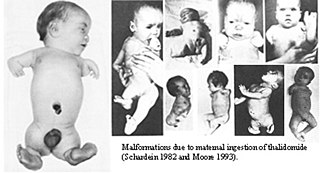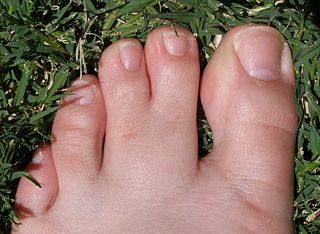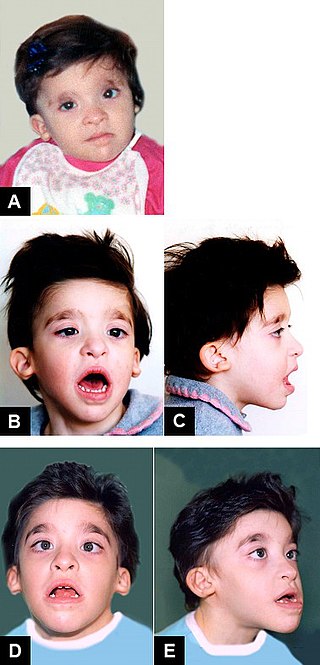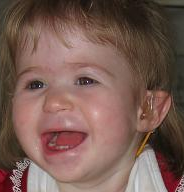Related Research Articles

Phocomelia is a congenital condition that involves malformations of human arms and legs which results in a flipper-like appendage. A prominent cause of phocomelia is the mother's use of the drug thalidomide during pregnancy; however, the causes of most cases are to be determined.

Brachydactyly is a medical term which literally means 'short finger'. The shortness is relative to the length of other long bones and other parts of the body. Brachydactyly is an inherited, dominant trait. It most often occurs as an isolated dysmelia, but can also occur with other anomalies as part of many congenital syndromes. Brachydactyly may also be a signal that one is at risk for congenital heart disease due to the association between congenital heart disease and Carpenter syndrome and the link between Carpenter syndrome and brachydactyly.

Polydactyly or polydactylism, also known as hyperdactyly, is an anomaly in humans and animals resulting in supernumerary fingers and/or toes. Polydactyly is the opposite of oligodactyly.

In biology, dactyly is the arrangement of digits on the hands, feet, or sometimes wings of a tetrapod animal. It comes from the Greek word δακτυλος = "finger".

Nail clubbing, also known as digital clubbing or clubbing, is a deformity of the finger or toe nails associated with a number of diseases, mostly of the heart and lungs. When it occurs together with joint effusions, joint pains, and abnormal skin and bone growth it is known as hypertrophic osteoarthropathy.

Lamellar ichthyosis, also known as ichthyosis lamellaris and nonbullous congenital ichthyosis, is a rare inherited skin disorder, affecting around 1 in 600,000 people.

Arthrogryposis (AMC) describes congenital joint contracture in two or more areas of the body. It derives its name from Greek, literally meaning 'curving of joints'.

Arachnodactyly is a medical condition that is characterized by fingers and toes that are abnormally long and slender, in comparison to the palm of the hand and arch of the foot. In some cases, the thumbs of an individual with the condition are pulled inwards towards the palm. This condition is present at birth.

Apert syndrome is a form of acrocephalosyndactyly, a congenital disorder characterized by malformations of the skull, face, hands and feet. It is classified as a branchial arch syndrome, affecting the first branchial arch, the precursor of the maxilla and mandible. Disturbances in the development of the branchial arches in fetal development create lasting and widespread effects.

Syndactyly is a condition wherein two or more digits are fused together. It occurs normally in some mammals, such as the siamang and diprotodontia, but is an unusual condition in humans. The term is from Greek σύν, syn 'together' and δάκτυλος, daktulos 'finger'.
Hypoplasia is underdevelopment or incomplete development of a tissue or organ. Although the term is not always used precisely, it properly refers to an inadequate or below-normal number of cells. Hypoplasia is similar to aplasia, but less severe. It is technically not the opposite of hyperplasia. Hypoplasia is a congenital condition, while hyperplasia generally refers to excessive cell growth later in life.

Mowat–Wilson syndrome is a rare genetic disorder that was clinically delineated by David R. Mowat and Meredith J. Wilson in 1998. The condition affects both males and females, has been described in various countries and ethnic groups around the world, and occurs in approximately 1 in 50,000-100,000 births.

1p36 deletion syndrome is a congenital genetic disorder characterized by moderate to severe intellectual disability, delayed growth, hypotonia, seizures, limited speech ability, malformations, hearing and vision impairment, and distinct facial features. The symptoms may vary, depending on the exact location of the chromosomal deletion.

Camptodactyly is a medical condition that causes one or more fingers or toes to be permanently bent. It involves fixed flexion deformity of the proximal interphalangeal joints.
Congenital contractural arachnodactyly (CCA), also known as Beals-Hecht syndrome, is a rare autosomal dominant congenital connective tissue disorder. As with Marfan syndrome, people with CCA typically have an arm span that is greater than their height and very long fingers and toes. However, Beals and Hecht discovered in 1972 that, unlike Marfan's, CCA is caused by mutations to the fibrillin-2 (FBN2) gene rather than the fibrillin-1 (FBN1) gene.
Thumb hypoplasia is a spectrum of congenital abnormalities of the thumb varying from small defects to complete absence of the thumb. It can be isolated, when only the thumb is affected, and in 60% of the cases it is associated with radial dysplasia. Radial dysplasia is the condition in which the forearm bone and the soft tissues on the thumb side are underdeveloped or absent.

Ectrodactyly, split hand, or cleft hand involves the deficiency or absence of one or more central digits of the hand or foot and is also known as split hand/split foot malformation (SHFM). The hands and feet of people with ectrodactyly (ectrodactyls) are often described as "claw-like" and may include only the thumb and one finger with similar abnormalities of the feet.
Dahlberg Borer Newcomer syndrome is a rare autosomal X-linked recessive genetic condition characterized by a prolapse of the bicuspid valve, progressive kidney failure, congenital lymphedema, hypoparathyroidism, and very short end bones of fingers.

Constriction ring syndrome (CRS) is a congenital disorder with unknown cause. Because of the unknown cause there are many different, and sometimes incorrect names. It is a malformation due to intrauterine bands or rings that give deep grooves in, most commonly, distal extremities like fingers and toes. In rare cases the constriction ring can form around other parts of the fetus and cause amputation or even intrauterine death. The anatomy proximal to the site of constriction is developmentally normal. CRS can be associated with other malformations with club foot being most common. The precise configuration of the bands, lymphedema, and character of the amputations are not predictable and vary with each individual patient. Also, more than one extremity is usually affected, and it is rare for only one ring to present as an isolated malformation with no other manifestation of this syndrome.
References
- ↑ James, William; Berger, Timothy; Elston, Dirk (2005). Andrews' Diseases of the Skin: Clinical Dermatology (10th ed.). Saunders. p. 783. ISBN 978-0-7216-2921-6.
- ↑ Baran R, Stroud JD (February 1984). "Congenital onychodysplasia of the index fingers. Iso and Kikuchi syndrome". Arch Dermatol. 120 (2): 243–4. doi:10.1001/archderm.1984.01650380103022. PMID 6696480.